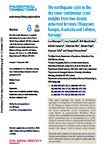The earthquake cycle in the dry lower continental crust: insights from two deeply exhumed terranes (Musgrave Ranges, Australia and Lofoten, Norway)
| dc.contributor.author | Menegon, L | en |
| dc.contributor.author | Campbell, L | en |
| dc.contributor.author | Mancktelow, N | en |
| dc.contributor.author | Camacho, A | en |
| dc.contributor.author | Wex, S | en |
| dc.contributor.author | Papa, S | en |
| dc.contributor.author | Toffol, G | en |
| dc.contributor.author | Pennacchioni, G | en |
| dc.date.accessioned | 2021-10-13T12:17:53Z | |
| dc.date.available | 2021-10-13T12:17:53Z | |
| dc.date.issued | 2021-03-22 | en |
| dc.identifier.issn | 1364-503X | en |
| dc.identifier.other | 20190416 | en |
| dc.identifier.uri | http://hdl.handle.net/10026.1/18046 | |
| dc.description.abstract |
<jats:p>This paper discusses the results of field-based geological investigations of exhumed rocks exposed in the Musgrave Ranges (Central Australia) and in Nusfjord (Lofoten, Norway) that preserve evidence for lower continental crustal earthquakes with focal depths of approximately 25–40 km. These studies have established that deformation of the dry lower continental crust is characterized by a cyclic interplay between viscous creep (mylonitization) and brittle, seismic slip associated with the formation of pseudotachylytes (a solidified melt produced during seismic slip along a fault in silicate rocks). Seismic slip triggers rheological weakening and a transition to viscous creep, which may be already active during the immediate post-seismic deformation along faults initially characterized by frictional melting and wall-rock damage. The cyclical interplay between seismic slip and viscous creep implies transient oscillations in stress and strain rate, which are preserved in the shear zone microstructure. In both localities, the spatial distribution of pseudotachylytes is consistent with a local (deep) source for the transient high stresses required to generate earthquakes in the lower crust. This deep source is the result of localized stress amplification in dry and strong materials generated at the contacts with ductile shear zones, producing multiple generations of pseudotachylyte over geological time. This implies that both the short- and the long-term rheological evolution of the dry lower crust typical of continental interiors is controlled by earthquake cycle deformation.</jats:p> <jats:p>This article is part of a discussion meeting issue ‘Understanding earthquakes using the geological record’.</jats:p> | en |
| dc.language | en | en |
| dc.language.iso | en | en |
| dc.publisher | Royal Society, The | en |
| dc.title | The earthquake cycle in the dry lower continental crust: insights from two deeply exhumed terranes (Musgrave Ranges, Australia and Lofoten, Norway) | en |
| dc.type | Journal Article | |
| plymouth.issue | 2193 | en |
| plymouth.volume | 379 | en |
| plymouth.journal | Philosophical Transactions of the Royal Society A: Mathematical, Physical and Engineering Sciences | en |
| dc.identifier.doi | 10.1098/rsta.2019.0416 | en |
| plymouth.organisational-group | /Plymouth | |
| plymouth.organisational-group | /Plymouth/Faculty of Science and Engineering | |
| plymouth.organisational-group | /Plymouth/REF 2021 Researchers by UoA | |
| plymouth.organisational-group | /Plymouth/REF 2021 Researchers by UoA/UoA07 Earth Systems and Environmental Sciences | |
| dcterms.dateAccepted | 2020-09-14 | en |
| dc.rights.embargodate | 2021-10-14 | en |
| dc.identifier.eissn | 1471-2962 | en |
| dc.rights.embargoperiod | Not known | en |
| rioxxterms.versionofrecord | 10.1098/rsta.2019.0416 | en |
| rioxxterms.licenseref.uri | http://www.rioxx.net/licenses/all-rights-reserved | en |
| rioxxterms.licenseref.startdate | 2021-03-22 | en |
| rioxxterms.type | Journal Article/Review | en |
| plymouth.funder | THE GEOLOGICAL RECORD OF THE EARTHQUAKE CYCLE IN THE LOWER CRUST::NERC | en |


